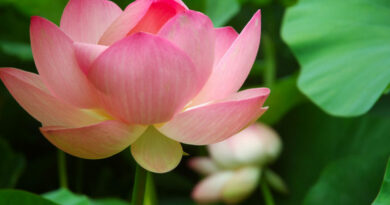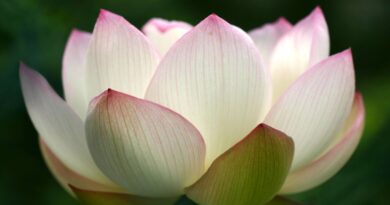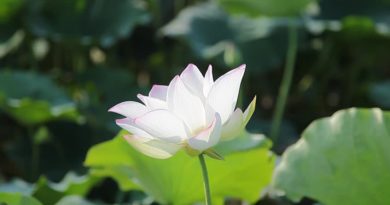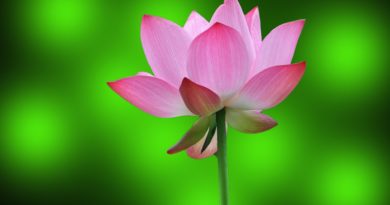HERE AND NOW – CHAPTER 2: SKILLFUL MEANS
The two aspects of our being are mind and body. We have to pay attention to both of them, even though meditation is a mind exercise, not a body exercise.
Some of the most common questions are: “How am I going to learn to sit?” “How am I not going to have any pain?” That is only possible through continued application, doing it again and again. In the beginning, the body just doesn’t like sitting cross-legged on the floor.
We can use this situation as skillful means. When discomfort arises in the body, we learn to pay attention to the mind’s reaction, and do not move automatically. Everybody in the world is trying to get out of any kind of discomfort with an instinctive, immediate reaction. It’s not that we’re not going to get out of discomfort, but in order to make meditation pay off, we have to learn to get out of instinctive, immediate reactions. It’s those that land us in //dukkha// over and over again.
When there is an uncomfortable feeling, it is essential to realize what is happening within. We notice that there is a sense contact, in this case “touch!” The body is making contact; the knees with the pillow, the legs with each other, several contacts are happening. From all sense contacts, feelings arise. There is no way out of that, this is how human beings are made. The Buddha taught cause and effect, that dependent upon any sense contact, feeling results. There are three kinds of feelings, pleasant, unpleasant and neutral. We can forget about the neutral ones, because we are hardly ever aware of them. Neutral is actually considered pleasant, because at least it doesn’t hurt. From this particular touch contact that is being made through the sitting posture, there arises, after a while, an unpleasant feeling. The immediate reaction is to move. Don’t! Investigate! By getting to know our own mind, we get to know the world and the universe. All minds contain the seed of enlightenment. Unless we know our own mind, we cannot develop and cultivate that seed. here the mind has been contacted with an unpleasant feeling, our perception says: “this is painful.” Our next step are the mental formations, which are also kamma formations, because we make kamma through our thought processes.
First came the sense contact, secondly feeling arose. Then perception, naming it, followed by dislike. At the moment of dislike, there is the running away through changing our position. That is the kamma making aspect. This is minor negative kamma, yet it’s negative, because the mind is in a state of ill-will by saying “I don’t like it.”
The mind may start all kinds of rationalizations: “I wish I’d brought my own little chair”; “I can’t sit”; “At my age I shouldn’t do things like this”; “Meditation is too difficult.” None of these explanations have any intrinsic validity, they are only a mind reacting to an unpleasant feeling. Unless we become acquainted with our mind’s reactions, we’re not using meditation in the most beneficial manner.
Knowing the unpleasant feeling, we can now try to acquaint ourselves with its true nature. Our whole life is lived according to our feelings. Unless we become aware of our reactions to feelings, we remain half asleep. There is a beautiful little book called //The Miracle of Being Awake//. This miracle is nothing but mindfulness, knowing what’s going on within. When we have realized we want to get rid of the unpleasant feeling, then we can try to disown it for a moment. Only the Arahant is fully capable of complete detachment, but we can do so for a short time. The unpleasant feeling has arisen without our asking for it and we don’t have to believe it to be ours. We can let it be just a feeling.
If we do that for a moment, we can get back to the meditation subject, and have won a victory over our own negative reactions. Otherwise we are letting our unpleasant feelings rule us in whatever way they want. The whole of humanity runs after pleasant feelings, and away from unpleasant ones. Unless we at least know that, we have no reference point for inner change. It may not be possible to reverse that reaction yet, but at least we know it is happening.
After we have become aware of our mind’s intention, we’re free to move and change our sitting position. There is nothing wrong with changing one’s posture but there’s something wrong with instinctive, impetuous habits. Meditation means total awareness. Being awake is not the opposite of being asleep; it is the opposite of being dull and foggy. Such mind states are mostly due to an unwillingness to look at our own //dukkha//. We’d rather hide in a fog. In meditation that won’t do. The Buddha said that this body is a cancer; the body as a whole is a disease, and we can experience that when just sitting still, it becomes uncomfortable.
Meditation means //samatha// and //vipassana//, calm and insight. Unless we know the limitations of each and also their possibilities, we won’t be able to make good use of the practice. We are generally applying both of them in every session, but we must be able to distinguish between them. If there is no understanding of what’s happening in the mind, the fog settles down in it.
Everybody would like bliss, peace and happiness. That is a natural wish. They are available in meditation, with a lot of practice, and some good kamma. However they are not the goal of meditation. The goal of meditation is insight. Yet skillful means for gaining insight are needed and are found in tranquillity meditation.
Making use of a meditation subject, the mind, after some training, will be able to stay on it for a while. Presuming that the mind is able to focus on the breath for even a short time, we realize afterwards that some peace arose, because the mind was not thinking. The thinking process in everybody’s mind is hardly ever profound. It’s just thinking. Just as the body breathes, so the mind keeps churning. And it keeps churning out mostly irrelevant, unsubstantial and unimportant details, without which we would be much happier.
The mind in its original form is pure. It’s clear and lucid, luminous, pliable and expandable. Our thinking is the impurity and the blockage. There’s hardly a person who doesn’t think all day long, probably without even being aware of it. But when we start meditating, we do become aware of our inner restlessness. We realize we can’t keep the mind on the meditation subject, because we are thinking instead of meditating. The moment we experience our thinking habit (even that takes time to realize) we accomplish two things. We become aware of our mind’s activity and also the content of our thoughts. We will realize immediately that our thinking is irrelevant and makes little or no sense. Because of that, we can let go of it fairly easily and return to the meditation subject. We have to be able to stand back and watch the thinking process and not get involved in it. Otherwise we’ll just keep on thinking instead of meditating.
The mind is the greatest and most delicate tool existing in the universe. All of us have it, but few look after it properly. Practically everybody is interested in looking after their bodies. Eating, sleeping, washing, exercising, seeing the doctor when the body is sick, cutting hair, nails, filling teeth, doing everything that’s necessary to keep the body functioning well. In reality, the body is the servant and the mind is the master. So we are looking after the servant and forgetting the master. If we do that in our homes, we create chaos. That’s one of the reasons why the world looks as chaotic as it does. People kill each other, steal from each other, are unfaithful, lie, gossip and slander. Most have absolutely no ideas that the mind is our most precious asset. It gives us wealth beyond compare and yet we don’t know how to look after it.
We have to do exactly the same thing for the mind as we do for the body. We need to give it a rest. Imagine if we didn’t go to sleep for three or four days, how would we feel? Without energy, without strength, pretty terrible. The body needs a rest, but the mind does too. During the day it thinks, at night it dreams. It’s always busy. The only real rest it can ever get, which energizes and gives the needed boost to become clear and lucid, is to stay on the meditation subject.
The mind needs a clean-up, which means purification. This happens when all thinking is stopped for a while, because of one-pointed concentration. One moment of concentration is one moment of purification. At that time the mind cannot contain ill-will or sensual desire, or any other negativity. When the concentration ceases, the mind reverts to its usual behavior again. In meditation we can experience that a purified mind gives us happiness, and quite naturally we will try to keep that purification process going also in daily living.
The mind needs the kind of exercise that is not geared towards winning or achieving anything, but just to obey. When we ask the mind to stay on the meditation subject, yet it runs away from it, we know immediately that we are not the master of our mind, but that the mind does what it pleases. When we have realized that, we will be less likely to believe our own views and opinions, particularly when they are unwholesome, because we understand that the mind is simply thinking habitually. Only through the meditation process can we become aware of that. The mind also requires the right kind of food. Because in meditation we can reach states of higher consciousness, we are thereby able to nourish the mind in a way which cannot happen in the ordinary thinking process. Tranquillity meditation leads the mind into realms which are totally unavailable to us otherwise. Happiness and peacefulness arise without dependence on outer conditions, which give us a new freedom.
The mind of every human being contains the seed of Nibbana. We need training in order to realize what is obscuring our vision. Then the seed can be cultivated and nurtured to full growth. Because our minds contain such a potential, they also contain the peace and happiness which everybody wants. Most people try to find fulfillment through acquiring material objects, seeing or touching, eating or knowing them. Particularly having more and keeping it all safe.
This dependency is a guarantee for //dukkha//. As long as we depend on outer conditions, whether people, experiences, countries, religions, wealth or fame, we are in constant fear of losing our footing, because everything changes and vanishes. The only way we can have real peace and happiness, is by being independent of all around us. That means gaining access to the purity of our mind without thinking, which involves staying on our meditation subject long enough for our consciousness to change. The thinking consciousness is the consciousness we all know. It contains constant ups and downs, either liking or disliking, wanting something in the future or regretting something about the past, hoping for better days or remembering worse ones. It is always anxious and cannot be expected to be totally peaceful.
We are familiar with a different consciousness also, for instance when we love someone very much. That emotion changes our consciousness to where we are only giving from the heart. We know a different consciousness when we are involved with religious activities, with faith and confidence aroused. We are giving ourselves to an ideal. None of that lasts through, and all depends upon outer conditions.
Through meditation we can change our consciousness to an awareness of purity within, which all of us have, only obscured through thinking. At that time we realize that such an independent peace and happiness are only possible when the “me” and “mine” are forgotten for a moment, when “I want to be happy” is eliminated. It is impossible to have peace when thinking about “self.” This will be our first inkling of what the Buddha meant, when he said non-self (//anatta//) is the way out of //dukkha//.
Because it is difficult for the mind to stay on the meditation subject, we have to use everything that arises for insight. Eventually the mind becomes clear and sharp and is no longer bothered by the outer manifestations that touch upon it, such as sound and thought, which are the most common ones. Finally a depth of concentration is reached.
When unpleasant feelings arise let us use them for insight. We didn’t ask for the feelings, why are they ours? They are certainly changeable, they get worse or better, they move their position, and they give us a very good indication that the body is //dukkha//.
The body isn’t doing anything except sitting, and yet we have //dukkha//, for the simple reason of not liking the feeling as it is. When we use the unpleasant feeling to actually realize the first and second noble truths, we’ve come nearer to the Dhamma in our hearts. The first noble truth being the noble truth of //dukkha//, the second being the reason for //dukkha//, namely craving. In this case, we’re craving to get rid of the unpleasant feelings. If we were totally accepting of the feeling, not making any value judgments, there would be no //dukkha//.
We can try letting go of this craving for a moment; anyone with some strength of mind can do that. Just accepting the feeling as it is, not disliking it. Then there’s no //dukkha//, for just that moment. That will be a profound insight experience, because it will show without the shadow of a doubt, that if we drop our desires, //dukkha// disappears. Naturally when the body feels uncomfortable, it’s difficult to drop the craving to get rid of that discomfort. But anybody can do it for just one moment, and it’s an essential and in-depth experience of the Dhamma.
When we are able to step back to observe our thought processes we realize that the mind is continually thinking. It may take from 5-10 minutes to become aware of that, for someone who hasn’t practiced meditation previously. For an experienced meditator it may only take a second or two. Next we can see what kind of thinking we are indulging in and the more often we see it, the less enraptured we’ll be with it. We become aware of the fact that this is the way the human mind acts, not just ours, but everybody’s and we’ll know the truth about the mind. There is nothing else to be seen except that. When we observe that the thinking goes on and that it is insignificant, it will be so much easier to let go. We also see how very fleeting thoughts are, how they come and go all the time. We’ll know from experience then, that no real happiness is to be found in something so short-lived, yet the whole world is trying to achieve happiness that way. We can’t even remember what we thought a moment ago, how can that bring happiness? Such insights make it possible to drop the distractions and get back to the meditation subject.
We are using the two approaches of calm and insight in conjunction with each other. When calm is firmly established, insight arises spontaneously. It’s important to realize that calm meditation is essential. If isn’t as if some people like it and others don’t.
If the ocean has high waves and we want to look beneath the surface to see what can be found there, we can’t recognize anything at all while the waves are rising. There is too much movement, all is stirred up and nothing is to be seen. When the waves subside and the ocean surface becomes calm and transparent, then we can look underneath the surface of the water and see sand, coral and multi-colored fish. It’s the same in the mind. When the mind has all the waves and motions of thinking, that churning in the mind makes it impossible to see absolute reality. On the contrary, the mind refuses to look beyond ordinary knowing. But when the mind becomes totally calm, then there is no value judgment, and we can see easily what lies underneath the surface.
In order to understand the Buddha’s teaching, we have to get below the surface, otherwise our insights will be superficial. The calm mind is the means for delving below relative reality. While we are trying to become calm, at the same time we’re objectively examining all that arises, so that there is more and more support for letting go of the thinking. The less we believe in our thoughts, the less we expect of them and the happier we will be to let them go. Then we get an inkling of what inner peace and happiness mean.
These inner feelings are most pronounced in meditation, but can be carried into daily living in a milder form, primarily because the mind knows it can always return to peace and happiness in meditation, without having to depend on any situation or any person. Worldly affairs no longer have the former sting in them; they are just happening, that’s all, the same as thinking and feeling are arising and ceasing, without an owner or a maker.
Source: Budsas.net







